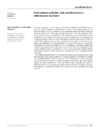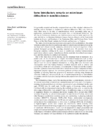issue contents
November 2005 issue

Cover illustration: MicroGISAXS scattering spectra of progressive protein crystallization by the nanotemplate method (see Pechkova, Roth, Burghammer, Fontani, Riekel and Nicolini, pages 713-716).
facility information
nanobioscience
Free 

Free 

Methodological developments for studying a protein nanotemplate experimental setup by microbeam grazing incidence small-angle X-ray scattering are described.
Small-angle X-ray scattering is a very appropriate tool for studying the liquid-crystalline phase behaviour of surfactant/water systems in situ. Alignment at the sample–glass interface and re-ordering tendencies of the surfactant molecules after heat treatment could be observed.
Open  access
access
 access
accessAn investigation of the calcified eggshell nanotexture by microfocus small-angle X-ray scattering using synchrotron radiation is reported.
The macroscopic and nanoscopic mechanical tensile behaviors of human aortas have been studied using a newly designed tensile testing device and synchrotron radiation.
The application of SAXS to investigate thermal-induced phase transitions in self-assembled mesoporous films is presented.
The orientation distribution of cellulose microfibrils in flax fibres and pine wood was measured by X-ray diffraction in situ during tensile tests. The relation of mechanical properties to structural changes in the materials is discussed.
Using microfluidics, the formation of liquid-crystalline droplets in water and the intercalation process of DNA into multilamellar membranes is investigated by means of small-angle X-ray scattering.
Open  access
access
 access
accessAn overview of synchrotron-radiation-based X-ray diffraction experiments regarding different levels of molecular architecture in fibril-based tissues is presented. Specific reference is given to collagen and fibrillin, two important fibrous proteins that comprise the bulk of the extracellular matrix in the animal kingdom.
Progress in the development of X-ray optics, together with the high brilliance of X-rays from a synchrotron radiation source (ESRF), has allowed the investigation of single carbon fibres. Microdiffraction experiments with beam sizes down to 100 nm have been performed to obtain structural information on the fibres under bending and tensile loads.
An investigation of single high-performance fibres using an X-ray waveguide, and an assessment of the influence of morphological averaging on experimental results.
Lysozyme crystals grown by protein nanotemplates display an increased stability to synchrotron radiation associated with changes in water content and α-helix, as shown by X-ray crystallography, circular dichroism, high-resolution NMR and mass spectrometry. Evidence for protein direct transfer from the nanotemplate to the drop and to the crystal is also provided.
Crystallization of proteins from a purified protein solution remains a bottleneck in the structure determination pipeline. The crystallization problem is addressed using a microfluidic device capable of determining detailed protein precipitation diagrams using less than 10 µL of protein sample.
research papers
The possibility of performing a spatial and temporal analysis of a speckle pattern generated by coherent synchrotron radiation scattered from a liquid surface is demonstrated. Unique surface sensitivity is achieved by applying the X-rays under a grazing angle of incidence. The appearance of the speckle image can be explained by use of geometrical arguments and by the fact that liquid surfaces have very small roughness values.
X-ray beam-position detection with spatial resolution in the sub-micrometre regime is achieved by combining a low-cost X-ray camera with a straightforward data analysis.
Open  access
access
 access
accessA CCD-based two-dimensional in situ beam-position and profile monitor for synchrotron X-ray beamlines is presented.
Reciprocal space mapping has been applied to map scattering rods of well oriented organic microcrystals. Formulae are provided to correct image distortions and to determine the required oscillation range for properly integrated intensities.
A case study on time-resolved X-ray powder diffraction experiments using free-electron laser sources is presented. Estimates of the photon flux at the detector for diffraction from a model compound in a wide q-regime and for varying resolution suggest that single-shot experiments are feasible in the case of the LCLS or the European XFEL.
A micro-pixel chamber (µ-PIC), which is a micro-pattern two-dimensional imaging detector, has been applied to X-ray crystallography. Diffraction spots were successfully obtained, and good internal agreement factors were confirmed
A mode-locked laser has been introduced in combination with synchrotron radiation to establish a versatile technique for highly time-resolved correlation measurements utilizing the short-pulse and high-pulse frequency characteristics of both photon sources.
laboratory notes
The design of a pulsed laser deposition chamber for in situ X-ray diffraction studies is presented.
new commercial products
Free 

current events
Free 



 journal menu
journal menu
















































